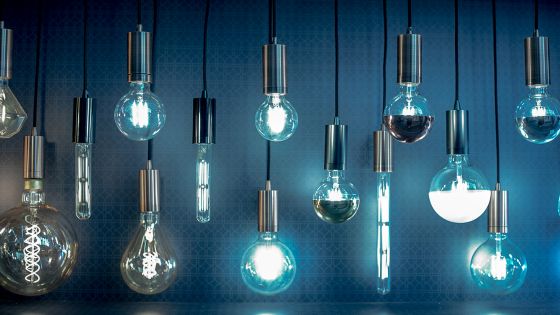Commercial lighting is a vital aspect of any business operation, as it plays a critical role in enhancing the overall aesthetics of the premises, ensuring safety, and providing the necessary illumination to support daily activities. However, lighting can also be a significant source of energy consumption and cost for commercial establishments. This is why businesses need to choose the right commercial lighting that is energy-efficient and cost-effective. In this article, we will explore different types of commercial lighting available and guide you on how to choose the right one for your business.
Types Of Commercial Lighting:
There are several types of commercial lighting available in the market, each with its unique features and benefits. The following are few of the most popular types of commercial lighting:
- LED Lighting: LED (Light Emitting Diode) lighting is one of the most popular types of commercial lighting available in the market. LED lights consume very less energy than traditional lighting and have a longer lifespan. They also emit less heat, making them an excellent choice for businesses that want to reduce their energy consumption and lower their cooling costs.
- Fluorescent Lighting: Fluorescent lighting is another popular type of commercial lighting that has been in use for several decades. Fluorescent lights are energy-efficient and emit less heat than traditional lighting. They are also widely available and cost-effective, making them an excellent choice for businesses with tight budgets.
- High-Intensity Discharge (Hid) Lighting: HID lighting is commonly used in commercial establishments such as warehouses, parking lots, and street lighting. HID lights are highly efficient and emit bright light that is ideal for outdoor use. However, they consume more energy than LED and fluorescent lighting and require a ballast to operate.
- Incandescent Lighting: Incandescent lighting is the traditional type of lighting that has been in use for over a century. Incandescent lights are cheap and widely available but are highly inefficient and consume a lot of energy. They also emit a lot of heat, making them an unsuitable choice for businesses that want to reduce their energy consumption and lower their cooling costs.
Factors To Consider When Choosing Commercial Lighting:
When choosing commercial lighting, businesses need to consider several factors to ensure they make the right choice. The following are some of the critical factors to consider when choosing commercial lighting:
- Energy Efficiency: Energy efficiency is a critical factor to consider when choosing commercial lighting. Businesses should choose lighting that is energy-efficient to reduce their energy consumption and lower their energy bills. LED and fluorescent lighting are the most energy-efficient types of lighting available in the market.
- Cost: Cost is another critical factor to consider when choosing commercial lighting. Businesses should choose lighting that is cost-effective and fits their budget. LED lighting is more expensive than traditional lighting, but its long lifespan and energy efficiency makes it a cost-effective choice in the long run.
- Quality Of Light: Quality of the light is another critical factor to consider when choosing commercial lighting. Businesses should choose lighting that provides the right level of illumination for their premises and enhances the overall aesthetics. LED lighting provides a bright and natural light that is ideal for most commercial establishments.
- Maintenance And Replacement Costs: Maintenance and replacement costs are other critical factors to consider when choosing commercial lighting. Businesses should choose lighting that requires minimal maintenance and has a long lifespan to reduce their maintenance and replacement costs. LED lighting has longer lifespan than traditional lighting, which makes it an excellent choice for businesses that want to reduce their maintenance costs.
- Environmental Impact: The environmental impact of the lighting is another critical factor to consider when choosing commercial lighting. Businesses should choose lighting that has a minimal impact on the environment and promotes sustainability. LED lighting is highly energy-efficient and has a lower environmental impact than traditional lighting, making it an excellent choice for businesses that want to reduce their carbon footprint.
- Lighting Control: Lighting control is another critical factor to consider when choosing commercial lighting. Businesses should choose lighting that provides the necessary control and flexibility to adjust the lighting according to their needs. LED lighting is highly compatible with lighting controls such as dimmers, sensors, and timers, which makes it an excellent choice for businesses that want to have full control over their lighting.
Benefits Of Energy-Efficient Commercial Lighting:
Energy-efficient commercial lighting has several benefits that can help businesses save on costs and promote sustainability. The following are some of the key benefits of energy-efficient commercial lighting:
- Reduced Energy Consumption: Energy-efficient commercial lightings solutions such as LED and fluorescent lighting consume significantly less energy than traditional lighting. This results in reduced energy consumption and lower energy bills for businesses.
- Lower Operating Costs: Since energy-efficient commercial lighting solutions consume less energy, they also result in lower operating costs for businesses. This can be beneficial for businesses with large lighting needs such as warehouses, retail stores, and office buildings.
- Longer Lifespan: Energy-efficient commercial lighting solutions such as LED lighting have a longer lifespan compared to traditional lighting. This means that businesses can save money on replacements and maintenance costs in the long run.
- Improved Quality Of Light: Energy-efficient commercial lighting solutions provide a better quality of light compared to traditional lighting. LED lighting, for instance, produces a brighter and more natural light that is less harsh on the eyes.
- Environmental Benefits: Energy-efficient commercial lighting solutions help reduce greenhouse gas emissions and other pollutants associated with electricity production. This makes them excellent choice for businesses that want to reduce their carbon footprint and promote sustainability.
Calculating Energy Savings:
Calculating the potential energy savings from energy-efficient commercial lighting solutions can help businesses make informed decisions about which solution to choose. The following are the key factors that businesses need to consider when calculating energy savings:
- Wattage: The wattage of the lighting solution is a critical factor in determining its energy consumption. The lower the wattage, the less energy the lighting solution consumes.
- Hours Of Operation: The number of hours the lighting is in operation is another critical factor in determining its energy consumption. The longer the lighting is in operation, the more energy it consumes.
- Cost Of Electricity: The cost of the electricity is another critical factor to consider when calculating energy savings, the higher the cost of electricity, the more significant the potential savings from energy-efficient commercial lighting solutions.
- Type Of Lighting: The type of lighting is another critical factor to consider when calculating energy savings. LED and fluorescent lighting consumes significantly less energy than traditional lighting, which results in more significant energy savings.
Conclusion:
Choosing the right commercial lighting is critical for businesses that want to reduce their energy consumption and save on costs. Energy-efficient commercial lightings solutions such as LED and fluorescent lighting offer several benefits, including reduced energy consumption, lower operating costs, longer lifespan, improved quality of light, and environmental benefits. Businesses need to consider several factors when choosing commercial lighting, including energy efficiency, cost, quality of light, maintenance and replacement costs, environmental impact, and lighting control. Calculating the potential energy savings from energy-efficient commercial lighting solutions can also help businesses make informed decisions about which solution to choose. By choosing the right commercial lighting, businesses can reduce their energy consumption, save on costs, and promote sustainability.




















